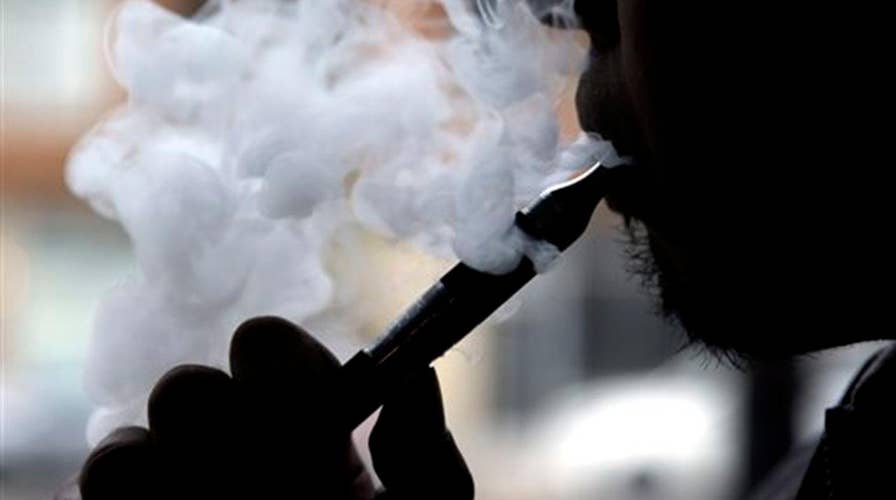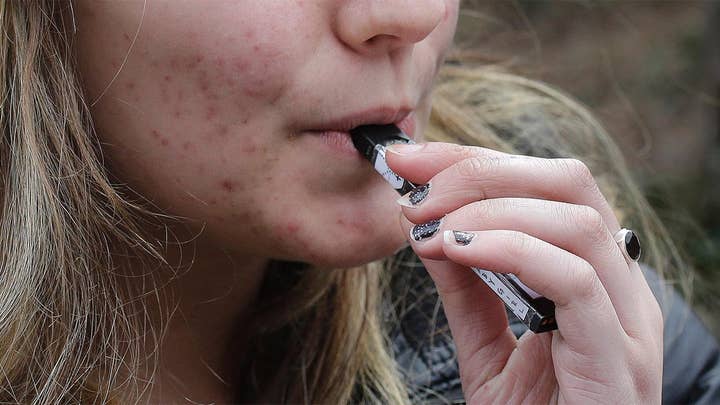FDA investigates more than 120 cases of people having seizures after vaping
Dr. Marc Siegel says vaping is a 'public health epidemic.'
Often touted as a safer alternative to cigarettes, e-cigarettes can have negative effects on a user’s blood vessels, damaging them after just one use, a new study says.
For the study, which was published Tuesday in the medical journal Radiology, researchers from the University of Pennsylvania performed MRI exams on 31 healthy, non-smoking adults before and after they used an e-cigarette that did not contain nicotine.
Participants — between the ages of 18 and 35 — were asked to take 16, 3-second hits from the vaping device.
POSSIBLE VAPING, SEVERE LUNG ILLNESS LINK SPARKS CDC PROBE
“To evaluate vascular reactivity, researchers constricted the vessels of the study participants’ thigh with a cuff and then measured how quickly the blood flowed after its release. Using a multi-parametric MRI procedure, researchers scanned the femoral artery and vein in the leg before and after each vaping episode to see how vascular function changed,” researchers explained in a news release regarding the findings.
The results? Researchers noticed a difference in the femoral artery — which supplies blood to the thigh and leg — after a “single episode of vaping,” according to the news release.
“The endothelium, which lines the inside surface of blood vessels, is essential to proper blood circulation. Once the endothelium is damaged, arteries thicken, and blood flow to the heart and the brain can be cut off, resulting in heart attack or stroke,” the researchers said.
More specifically, researchers, on average, noticed a “34 percent reduction in the femoral artery’s dilation,” as well as “17.5 percent reduction in peak blood flow, a 20 percent reduction in venous oxygen, and 25.8 percent reduction in blood acceleration after the cuff release,” or the speed at which blood returns to normal flow after it’s constricted, they said.
According to the study’s lead author, Alessandra Caporale, the results indicate that there are “significant changes” to the inner lining of blood vessels after vaping.
“E-cigarettes are advertised as not harmful, and many e-cigarette users are convinced that they are just inhaling water vapor,” Caporale said in a statement. “But the solvents, flavorings and additives in the liquid base, after vaporization, expose users to multiple insults to the respiratory tract and blood vessels.”
And though researchers noted more study is needed to evaluate the long-term health effects of vaping, their findings indicate e-cigarettes are “potentially much more hazardous than previously assumed.”
A specific chemical responsible for the changes was not identified.
The findings were released days after the Centers for Disease Control and Prevention (CDC) announced it is investigating whether a series of lung illnesses reported across multiple states is linked to vaping.
In a statement over the weekend, the federal health agency said it’s “providing consultation” to state health departments in Wisconsin, Illinois, California, Indiana, and Minnesota “about a cluster of pulmonary illnesses linked to e-cigarette product use, or ‘vaping’ primarily among adolescents and young adults.”
Last week, dozens of teens in the Midwest were hospitalized with lung issues that were possibly tied to vaping. Cases were primarily reported in Minnesota, Wisconsin and Illinois.
Patients reported similar symptoms – shortness of breath, chest pain, cough, and vomiting in some cases – and some were admitted to the intensive care unit (ICU). Teens across the states reported using vaping devices for both nicotine and THC, the psychoactive ingredient in marijuana that produces the “high” sensation, prior to their hospitalization.
"Clearly if there is an effect after a single use of an e-cigarette, then you can imagine what kind of permanent damage could be caused after vaping regularly over [the] years."
The negative health effects associated with cigarette and cigar use have long been documented, leading to a decline in both among teens in the U.S. in recent years.
In 2018, for example, the CDC reported roughly 1 in 50 – about 1.8 percent – of middle school students said they smoked cigarettes in the past 30 days, down from 4.3 percent in 2011 and a drastic decrease from 36.4 percent in 1997 when rates “peaked after increasing throughout the first half of the 1990s,” according to the American Lung Association.
But the same is not true for e-cigarette use. In 2018, nearly 1 of every 20 middle school students (4.9 percent) reported using electronic cigarettes in the past 30 days. That's an increase from less than 1 percent in 2011.
Last year, the surgeon general of the United States, Jerome Adams, declared vaping among American teens an “epidemic."
"This is an unprecedented challenge,” Health and Human Services Secretary Alex Azar said in response at the time.
“I would warn young people to not even get started using e-cigarettes. The common belief is that the nicotine is what is toxic, but we have found that dangers exist, independent of nicotine,” Felix Wehrli, the Penn study’s principal investigator, said of the findings.
“Clearly if there is an effect after a single use of an e-cigarette, then you can imagine what kind of permanent damage could be caused after vaping regularly over [the] years.”


